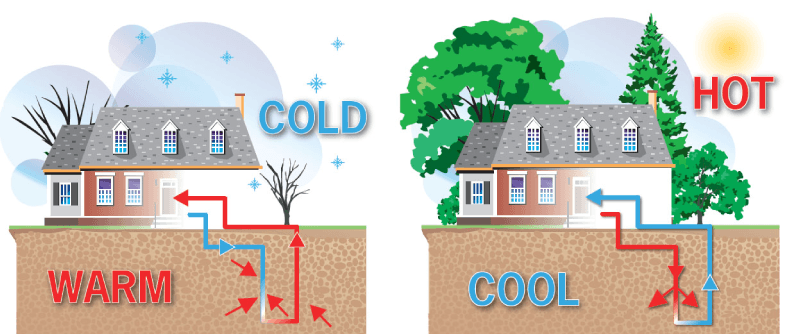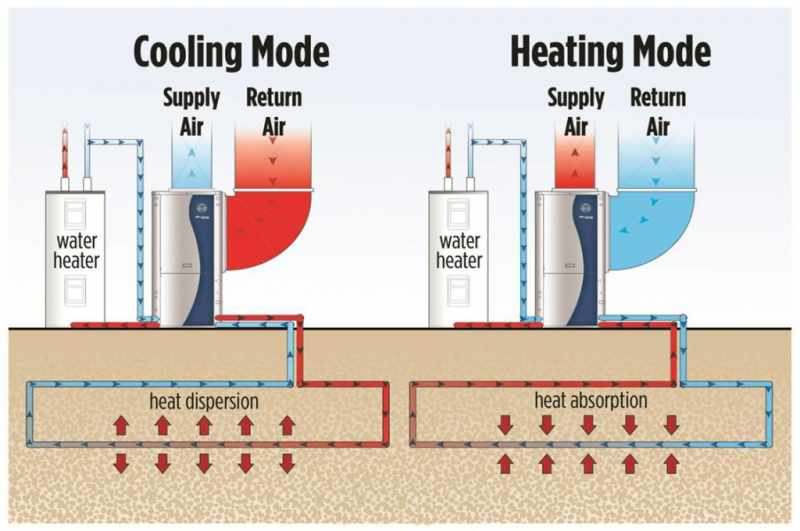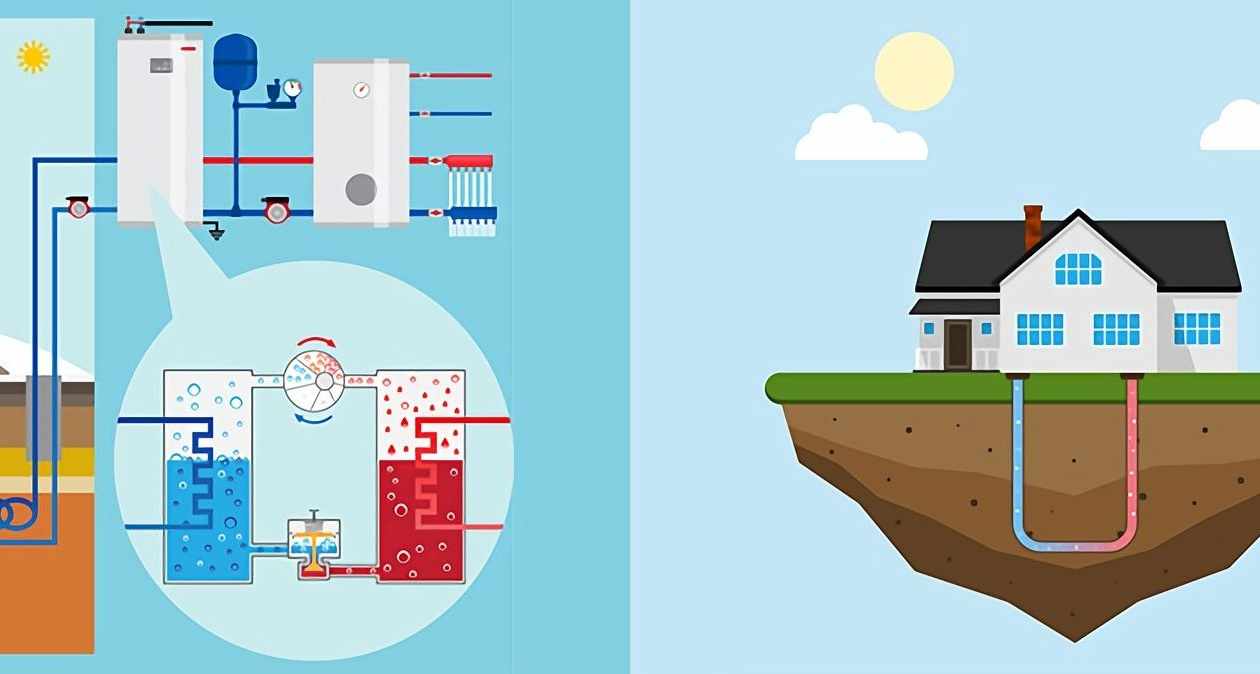Geothermal heating and cooling systems are gaining significant popularity, especially in areas where geothermal energy is available. It has many benefits, such as low operational costs, minimal maintenance requirements, eco-friendliness, and more.
However, many people don’t know what geothermal heating and cooling are and how it works. Here is a quick introduction to geothermal systems, along with their benefits and disadvantages.
Let’s get started.
What Is Geothermal Heating and Cooling?
Table of Contents
Geothermal heating and cooling refer to using geothermal energy for heating and cooling applications. Geothermal energy is a type of thermal energy that originates from the radioactive decay of materials in the earth’s crust. The temperature and pressure under the earth’s crust are high. It causes some rocks and other materials to melt, resulting in geothermal energy.
How Does Geothermal Heating and Cooling Work?
Now, how do geothermal heating and cooling work? Let’s understand it with a use case. Many houses nowadays come with geothermal systems. These systems transfer heat between the house and the earth’s surface. Earlier, most houses came with a traditional furnace system for heat regulation. Now, geothermal systems have replaced them.

A geothermal system installed in a house is connected to a buried pipe system, also known as ground loops. These pipes circulate heat transfer fluid. The fluid continuously transfers heat. During winter, it extracts heat from the ground and emits it into your home. In summers, it extracts heat from the air and transfers it to the ground. The air gets cooled under the ground and sent back inside the house.
Benefits of Geothermal Heating and Cooling Systems
Now that you’ve understood what geothermal heating and cooling is and how it works, let’s look at some of its benefits. Geothermal systems offer several advantages over traditional furnace systems. These include:
Eco-Friendly
Geothermal systems are one of the most eco-friendly systems out there. They don’t need fuel, and thus, they don’t emit carbon monoxide or other harmful gases. Hence, you don’t have to worry about creating pollution and your environmental impact. If you’re someone who cares about their environmental impact, geothermal systems can be an eco-friendly option for you.
Cost-Effective
Installing a geothermal system might come with some initial costs, but it’s affordable to operate in the long run. The initial components mainly include a geothermal heat pump, which is quite expensive. However, the technology has relatively lower operational costs, so you’ll save money in the long term.
There are two ways you save money with geothermal systems. First, these systems have an efficiency rating of up to 400%. So, they create four units of energy for every one unit of energy used. Second, these systems produce energy by transferring heat instead of burning fuel. Hence, you don’t have to incur fuel costs.
Moreover, experts say that a geothermal system starts paying for itself in 3-5 years of installation. The government also offers tax credits on installing geothermal systems.
Two-In-One System
A geothermal heating and cooling system is a two-in-one system. It has built-in heating and cooling functionalities, so you don’t need to pay for both components individually. This is unlike traditional systems, where you need to install different units for cooling and heating.

Easy Maintenance
A traditional HVAC system lasts for around ten years, provided that you maintain it regularly. Since these systems are located outside, they have a short shelf life, and you need to replace them every 10-15 years. On the other hand, geothermal systems reside inside the house. They don’t experience the natural wear and tear caused by heat, rain, and winter. As a result, these systems have a significantly longer shelf life. Some geothermal system providers offer up to 50 years of warranty.
What’s more, these systems require no maintenance. You can just install and forget about them. In addition to low costs, you also get the ease of use and peace of mind.
Safe and Secure
Geothermal systems are safe to operate with negligible risk of accidents. Traditional HVAC systems involve combustion, which increases the risk of fire. In fact, homes with standard furnace systems can be hazardous for kids. Additionally, such systems emit carbon monoxide and other harmful gases that can deteriorate the air quality in your house.
There’s no such risk associated with a geothermal system. You and your family don’t have to worry about fire or poor indoor air quality. Hence, not only are you safe from fire and accidents but also from problems like asthma.
Comfortable
You will also enjoy many comfort-related benefits after installing a geothermal heating and cooling system. One way a geothermal system increases comfort is by asking for negligible maintenance. Second, it makes your indoor environment very pleasant and comfortable. They provide perfect air purification and dehumidification, which improves indoor air quality.
Makes Less Noise
This may not be relevant to some homeowners, but many homeowners prefer quiet heating and cooling systems. If you’re one of them, geothermal systems are for you. These systems don’t need external condensing units, while the internal sections are explicitly designed to function quietly.
Are There Any Disadvantages of Geothermal Heating and Cooling?
Yes, there are a few drawbacks of geothermal heating and cooling you should know about before installing it. Here are some disadvantages of geothermal systems.
- These systems are location-specific and are available only where geothermal plants are installed.
- Though geothermal energy doesn’t produce harmful gases, it releases some pollutants that are trapped in the ground.
- Geothermal systems can trigger earthquakes, especially in high-risk areas.
- They have hefty initial installation costs.
- It’s not sustainable as it requires a consistent flow of fluid.
Conclusion
The use of geothermal energy is on the rise. Many people see it as an alternative to traditional HVAC systems and furnaces that require fuel and cause pollution. However, there’s still confusion and a lack of information about geothermal energy and how these systems work. The above guide can act as a starting point if you want to learn more.
However, remember that though geothermal energy has benefits, there are drawbacks as well that you should keep in mind. Compare the pros and cons to determine if it’s the right choice for you.





